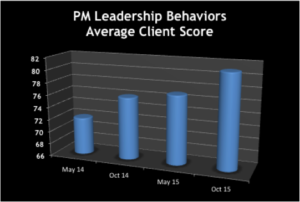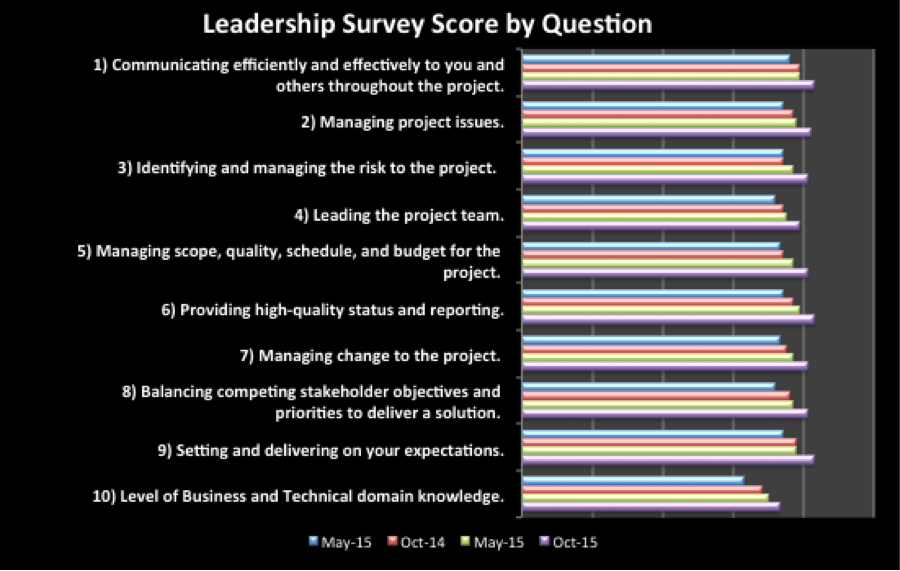Leadership is the holy grail of project management.
According to CEB Global, project managers that possess entrepreneurial (leadership) skills are 40% more likely to deliver project outcomes, but only 30% of project managers have these skills. A recent article in the Project Management Journal, “What Are The Characteristics That Software Project Team Members Associate with a Good Project Manager,” identified seven attributes of a good project manager all of which are leadership skills.
A few years ago, I started leading a large project management organization. The team primarily supported software projects for the company’s technology division. As I met my new clients, I heard a consistent theme, “the project managers acted more like list checkers—they did not demonstrate leadership.”
To be successful, my team would need to transform. We needed to change our culture from being project administrators to project leaders. I wanted to build a program where:
- Industry-based, quantifiable metrics would help guide the change and measure our progress.
- Leadership expectations are well defined, behavior based, and achievable;
- The process would be ongoing and sustainable.
“When you can measure what you are speaking about, and express it in numbers, you know something about it”—Lord Kelvin
The first step was finding a framework that resonated with our organization and described measureable behaviors. Inspiration came from Andy Crowe’s book, “The Alpha Project Manager.” In his quest to identify the traits of the best project managers, Crowe surveyed 860 project managers and their stakeholders. His research found that only 2% of the project managers met his alpha criteria. He also revealed that most project managers perceived their performance to be significantly higher than their stakeholders’ assessment.
The book and its findings were compelling and we adopted Crowe’s initial survey to define our desired leadership behaviors. We modified his questions so that they better fit our environment. We used the following criteria to assess the project managers:
- Communicating efficiently and effectively throughout the project
- Managing project issues
- Identifying and managing the risk to the project
- Leading the project team
- Managing scope, quality, schedule, and budget for the project
- Providing high-quality status and reporting
- Managing change to the project
- Balancing competing stakeholder objectives and priorities to deliver a solution
- Setting and delivering on your expectations
- Building domain knowledge and expertise
We established the following procedures for the survey:
- We employed a 360-evaluation method. Each project manager selected 3-5 project stakeholders to evaluate him or her. The project manager completed a self-assessment and their manager also rated their capabilities.
- Each question was scored on a scale of 1 to 100. A score of 50 was considered “satisfactory” performance. Scoring was on an absolute scale, so senior resources were expected (and tended) to have higher scores. We chose a 100 scale to provide room for space differentiation.
- We conducted the survey twice a year. Surveying more often might lead to fatigue, and less frequently would not provide enough feedback.
- The survey was not linked to our formal performance management process. We wanted the project managers to embrace the survey as a safe, self-assessment tool.
I shared the organizational-level metrics with the team, our clients, and our leadership. In these presentations, we shared general trends, areas of strength and opportunity, and the relative performance of sub-groups; for example: employees vs. service providers, senior vs. junior PMs, and performance by portfolio.

Managers also shared personalized results with each project manager. Individual respondents remained anonymous, but we shared the aggregated results. The intent was to provide each project manager with insights to help guide their personal growth and development.
Since the project managers and their managers assessed their performance, the process allowed us to calibrate perceptions and expectations. In our initial survey, the average perception gap (PM vs. client score) was 11 points; in subsequent rounds that gap fell to near zero.
We have now conducted the survey four times (two years) and have observed:
- Interest in the survey persists. We continue to have survey response rates close to 70%.
- Average scores have improved from 73 to 81 points—representing a 30% improvement.
- Generally, senior resources outperform more junior ones. There is also a 3-6 month learning curve for new project managers to acclimate to our environment.
- Generally, employees have higher scores than our managed service partners.
- Our performance against most of the leadership behaviors are close to the same level. Domain knowledge lags behind the other metrics and is related to experience in tenure with specific functional areas and applications.
“What gets measured gets done.”—Tom Peters
I have used metrics to support several organizational goals including adopting new methodologies and quality initiatives. My experience is that metrics are an effective tool. However, metrics alone will not drive the change. To support the leadership change, we provide training and learning opportunities, including:
- Formal training on effective communication techniques;
- Monthly focus topics that describe tangible steps that the project managers could take to raise their leadership profile; and
- Suggested external reading and self-directed learning opportunities.
After two years, I am proud of our accomplishments. We have created clear measures of performance. We have changed how the project managers are perceived and how they perceive themselves. The journey is on going. Leadership continues to be an important organizational goal.

© 2016, Alan Zucker, Project Management Essentials, LLC
Sources:
“Building Entrepreneurial Project Managers.” Entrepreneurial Project Managers. CEB Global. Web. 1 Dec. 2015. https://www.cebglobal.com/exbd/information-technology/pmo/project-manager-effectiveness/entrepreneurial-project-managers/index.page?
Crowe, Andy. Alpha Project Managers What the Top 2% Know That Everyone Else Does Not. Kennesaw, Georgia: Velociteach, 2006. Print.
Medina, Alicia, and Alison Francis. “Project Management Journal Volume 46, Issue 5, Article First Published Online: 4 SEP 2015.” What Are the Characteristics That Software Development Project Team Members Associate With a Good Project Manager? Project Management Institute, Inc., 1 Oct. 2015. Web. 1 Dec. 2015. http://onlinelibrary.wiley.com/doi/10.1002/pmj.21530/pdf
Peters, Tom. “What Gets Measured Gets Done – Tom Peters.” Tom Peters. 1986. Web. 2 Dec. 2015. http://tompeters.com/columns/what-gets-measured-gets-done/
“Who Said, “What Gets Measured Gets Managed”?” A Thinking Person Aka Cogit8R. 2 Dec. 2012. Web. 2 Dec. 2015. http://athinkingperson.com/2012/12/02/who-said-what-gets-measured-gets-managed/

